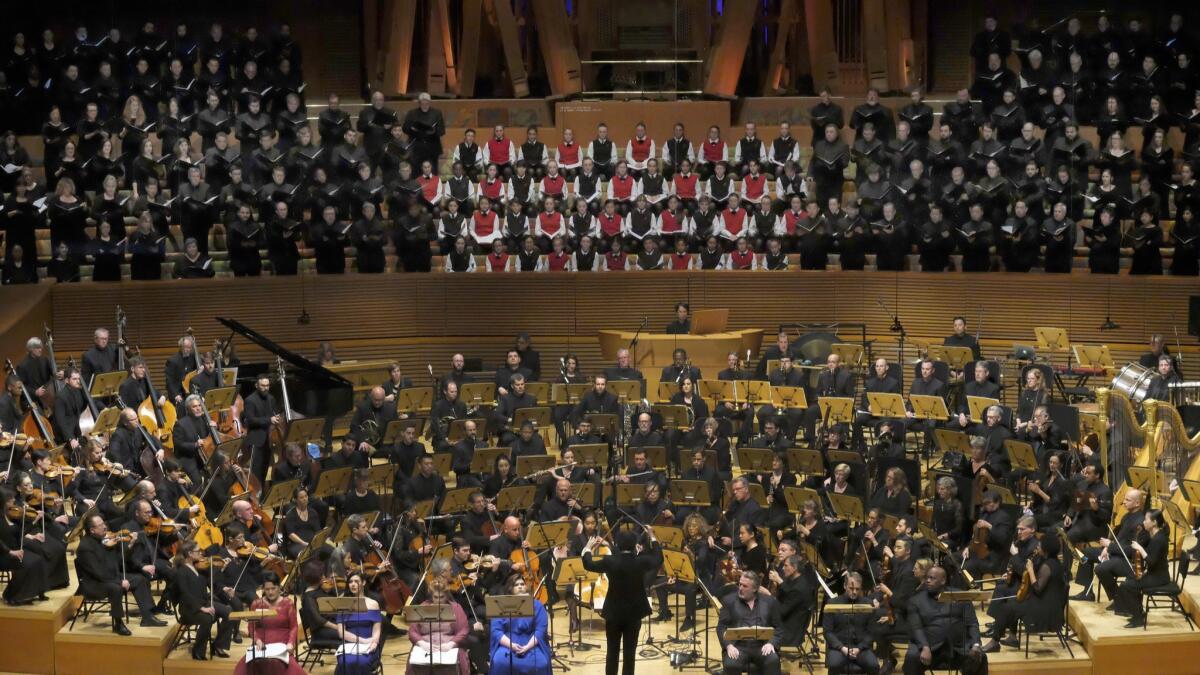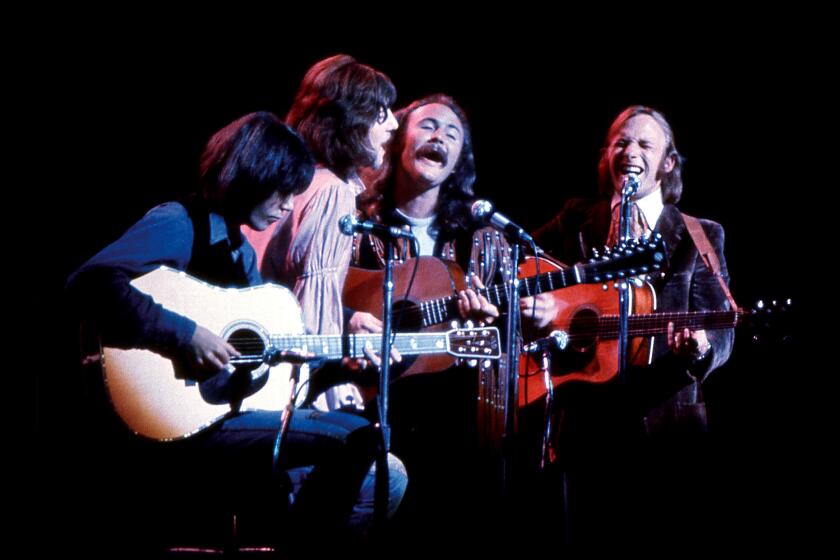Review: For Gustavo Dudamel, Mahler’s ‘Symphony of Thousand’ is a symphony of spirit

- Share via
Mahler’s Symphony No. 8, known as “Symphony of a Thousand,” is glory amplified.
Written for huge orchestra, massive chorus and eight vocal soloists, it is a hymn of ascension to a higher level of existence, to goodness beyond imagining. A climax of all possible climaxes, the score is the ultimate conduit for reaching the symphonic stars.
Exultant conductors begin music-director appointments basking in its exaltation and end tenures bathing themselves in its grandeur. New concert halls are inaugurated with it. Five-hundred-thousand-dollar loudspeakers expect to prove their worth by reproducing the effect of a live performance of Mahler’s Eighth in a majestic venue — and fail.
The symphony was given its first performance at Walt Disney Concert Hall on Thursday night and ended the Los Angeles Philharmonic’s centennial season with a third performance Sunday afternoon. In a reading as urgent as exultant, Gustavo Dudamel made the symphony the inevitable apogee of nine months’ worth of near quotidian historic big moments.
The obvious comparison is with the performance Dudamel led as culmination of his 2012 Mahler Project. A conductor not content with the 350 or so performers in a typical Eighth, he assembled in the Shrine Auditorium singers from all over town and employed a double-sized orchestra composed of the L.A. Phil and the Simón Bolívar Symphony Orchestra of Venezuela. This was a true “Symphony of a Thousand” (1,017 to be exact). Two weeks later Dudamel brought the L.A. Phil to Venezuela and repeated the Eighth in Caracas with a record-breaking 1,400 performers, the chorus of music students from all 17 Venezuelan states piled to the rafters of the Teatro Teresa Carreño Concert Hall.
“Wow” didn’t begin to describe the effect of a performance that also served as an incomparable political statement. Dudamel’s homeland was in the midst of a presidential election. The country was mired in problems, and there was nothing but talk of a more prosperous future.
The concert had been advertised “Con Dudamel por la Paz” (With Dudamel for Peace), and this Eighth was the country’s star conductor showing what was possible if everyone worked together. After that, had he been on the ticket, Dudamel would have been elected. I’m willing to bet the current Venezuelan talks in Oslo would go much better were the government to get over its anger with Dudamel and both sides take a break and watch the remarkable video of that performance together.
At Disney the L.A. Phil, Los Angeles Master Chorale, Pacific Chorale, Los Angeles Children’s Chorus, National Children’s Chorus and superb soloists numbered a reasonable 346. This still offered more than enough breathtaking acoustic power for magnificence. But the hall and the singers also provided a flexibility that Dudamel couldn’t possibly gain in the humongous Shrine or in Caracas.
Was Venezuela still on Dudamel’s mind? He hasn’t conducted the symphony again since those performances seven years ago and one more at the Salzburg Festival with the Venezuelans. Surely this Eighth was another message to crisis-ridden Venezuela in its astonishing Mahlerian insistence.
The symphony begins with a Latin hymn, “Veni creator spiritus,” to all that is holy. A pedal tone in the organ and low strings, like the rumble of a rocket’s engines firing up, is followed by a lurching choral outburst and great fanfares in the trumpets and trombones. There is throughout the opening a swelling of excitement, an expansive picture of praise.
This time on a mission, Dudamel had no time to linger on jubilation. He had the orchestra, chorus and soloists sculpt phrases as though they were questions needing deep investigation. One idea followed the next as in an inexorable argument that, when it reached the end of the movement, was not just physically thrilling but like discovering the inevitable and the ineffable.
The longer second part of the symphony is a setting of the final scenes to Goethe’s “Faust.” Opera, oratorio and symphony form one fantastic whole. Again Dudamel gave intense attention to detail, whether it be the setting of a forest scene, illuminating Mahler’s radiant kaleidoscopic orchestral color wheel or urging soloists and chorus to Wagnerian heights and then way beyond.
The L.A. Phil’s brilliance here was in that detailing. Dudamel has gone beyond mere beauty in his quest for Mahlerian meaning. But he has no qualms with robustness, and the combined choruses were capable of both grandeur and drama at the same time.
The soloists, from top to bottom, included the highflying Erin Morley, stationed under the organ pipes as pilot for the final ascent to heaven; a pair of soaring sopranos, Tamara Wilson and Leah Crocetto; two deeply sonorous mezzo-sopranos, Mihoko Fujimura and Tamara Mumford; and the robust tenor Simon O’Neill, the probing baritone Ryan McKinny and the weighty bass Morris Robinson.
Can radiance be recorded? Goosebumps digitized? We’ll find out. Deutsche Grammophon came to town to preserve a historic occasion for now and whatever media we rely in the future.
=====
L.A. Phil and Mahler’s Symphony No. 8
Where: Walt Disney Concert Hall, 111 S. Grand Ave., L.A.
When: 2 p.m. Sunday
Tickets: Limited availability, $146; check for returned tickets at various prices at the box office
Info: (213) 850-2000, laphil.com
More to Read
The biggest entertainment stories
Get our big stories about Hollywood, film, television, music, arts, culture and more right in your inbox as soon as they publish.
You may occasionally receive promotional content from the Los Angeles Times.











